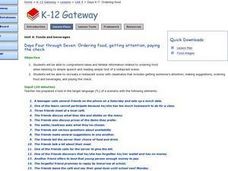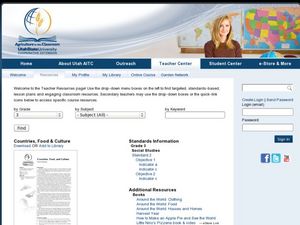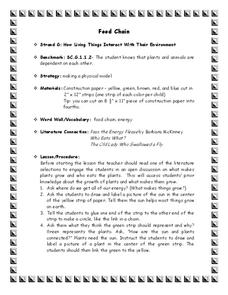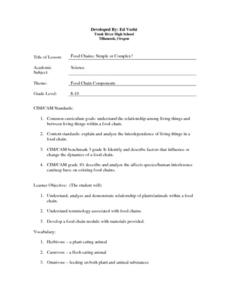EngageNY
End of Unit Assessment: Presentation of Position
What is the difference between formal and informal language? Pupils rewrite their position speeches to adapt them for an audience of adults. Next, they present their speeches in small groups, attempting to answer the question, "Which...
K20 LEARN
Speedy Cat: Enzymes
Enzymes have a need for speed! What happens when they are forced to slow down? A well-rounded lesson plan from the K20 Center examines enzyme activity through role playing and a lab. Biology scholars work in teams and pairs to understand...
National Wildlife Federation
Soil Decomposers
The class studies the soil food web that includes earthworms and conduct four experiments using the crawly critters. Individuals determine whether earthworms are sensitive to light, touch, temperature, and acid.
Nemours KidsHealth
Healthy Snacking: Grades K-2
Two lessons, all about snacking, look closely at how to make smart, balanced choices. Lesson one challenges pupils to create a menu for the hypothetical restaurant, The Snack Shack. Lesson two offers a variety of informative...
Curated OER
Food Sources
Students develop a working vocabulary of food by categorizing foods by their sources or origins. Working in groups, they determine at least four ways in which food is grown or produced. Groups create a poster by diving selected food...
Curated OER
Talking about Food, Expressing Likes and Dislikes
Students explore foods. In this nutrition instructional activity, students chorally respond to questions about a kitchen PowerPoint, complete a Venn diagram about breakfast and lunch foods, and play a food Bingo game.
Curated OER
Food Guide Pyramid
Learners develop an understanding of the Food Guide Pyramid by creating sample meals and examining whether there is a relationship between how foods are grown and where they fall in the Food Guide Pyramid. They also complete a scavenger...
Curated OER
Foods and Beverages
Learners practice ordering food in a new language. In this food vocabulary lesson, students utilize the information from their previous lesson to create entire conversations about going to get food, as opposed to just the...
Curated OER
Food Guide Pyramid: rice
First graders study and answer questions about the food guide pyramid and find the rice in the pyramid. In this food pyramid lesson plan, 1st graders test their families on their knowledge of the pyramid by asking the given questions.
Curated OER
Create a Food Chain
Students build food chain pyramid from teacher-created carton cubes, and discuss plants and animals and their places in the food chain.
Curated OER
Countries, Food and Culture
Third graders explore food production by researching culinary culture on the Internet. In this global food lesson, 3rd graders read assigned text about the different dietary habits of foreign cultures based upon their environment....
Curated OER
Food Chain
Young scholars explore the cycle of how each living thing gets food. In this food chain unit, students participate in four lesson plans that highlight animal vocabulary, habitats, and the role of humans in our ecosystem. Young scholars...
Curated OER
Forest Food Chains and Webs
Students explore forest ecological systems. In this ecology lesson, students classify forest plants and animals according to their ecological roles. Students play a related vocabulary guessing game. Students choose a card on which...
Curated OER
Food Chain/Food Web
Students explore ecosystems. In this ecology lesson, students read an article explaining ecosystems. Students create a visual organizer with index cards using components of various ecosystems.
Curated OER
Food Chain
Students discuss what makes plants grow and who eats the plants. They are asked where do we get all of our energy? Students are asked to draw and label a picture of the sun in the center of the yellow strip of paper. They are explained...
Curated OER
Food and Kitchen Safety Lab
Students review kitchen management, safety, and sanitation rules, and practice applying safety and sanitation rules in kitchen lab by preparing chicken stir-fry over rice while maintaining safe working environment. Students then complete...
Curated OER
Food Pyramid Showdown
In this health worksheet, students answer 30 questions cards about healthy eating. For example, "How many servings of vegetables should you have?"
Curated OER
Food Chains: Simple or Complex?
Students explore the relationships within the food chain between plants and animals. They construct modules of food chains, keeping them simple and not complex. They focus on what the animals eat and not on what eats it.
Curated OER
Three Healthful Meals: A Practical Food-Guide-Pyramid Activity
Students activate their knowledge of the food guide pyramid and the basic food groups in order to plan nutritious meals. They collect a handful of food images from magazines and glue them to the appropriate plates.
Curated OER
Ways to the Heart: Food and Foodways in Hawai'i
Students explore the Hawaiian culture through food. In this cultural appreciation lesson plan, students use map skills to locate where the food originated. They also discuss the importance of food to a culture's heritage, and...
Curated OER
Where Does Our Food Come From?
Fourth graders identify the state or country that a food product came from and locate it on a map. They identify products that are grown in Hawaii and the factors important in the location of economic activities.
Curated OER
Imports and Exports for Making a Food Pyramid
Students examine the food pyramid and discuss it nutritional value. They play a game to determine what types of foods and number of servings they need to complete food pyramids. they can i"import" or "export" cards with foods they need...
Curated OER
Food and Culture, Past and Present in Choctaw Culture
Students explore the Choctow culture. In this Choctow lesson, students use their research skills to create presentations that feature Choctow geography, resources, tradition, foods, and health issues.
Curated OER
Food & Science - How Healthy is Your Diet?
Learners experiment with various foods to determine fat and starch content. They rub jam, peanut butter, bananas, and other foods in a small circle on a piece of paper, and observe the results. If there is a high fat content in the...
Other popular searches
- Food Pyramid
- Food Chains
- Food Groups
- Food Webs
- Food Labels
- Food Safety
- Desert Food Chain
- Esl Lessons Food
- Animal Food Chain
- Deciduous Forest Food Chains
- Nutrition Labels
- Healthy Foods






















